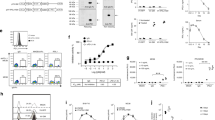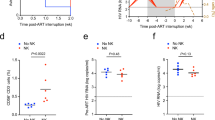Abstract
The in vivo elimination of suicide gene-expressing tumor cells with prodrug treatment can induce protective immunity against wild-type tumors. In this study, we determined the efficacy and safety of the in vivo elimination of HSVtk expressing cells with ganciclovir treatment of a bystander cell killing-insensitive leukemic cell line. The retroviral construct pLTk+NeoΔMo, containing the HSVtk gene and the NeoR gene in a bicistronic unit, was introduced into rat leukemic LT12 cells. LT12/Tk+N cells showed a 1000- to 10 000-fold increased sensitivity to ganciclovir in vitro. In vitro mixing experiments demonstrated that LT12 cells were not susceptible to bystander cell lysis by LT12/Tk+N-2 cells exposed to ganciclovir. Rats injected s.c. with cloned LT12/Tk+N-2 cells developed tumors reaching a diameter of 3–4 cm after 40 days. Rats treated with gan- ciclovir twice daily for 5 consecutive days starting at day 7 did not develop s.c. tumors. Large established s.c. LT12/Tk+N-2 tumors completely regressed after ganciclovir treatment. However, recurrences of s.c. tumors were observed that were no longer sensitive to ganciclovir treatment. In vitro analysis of aspirates from the recurrent tumors demonstrated loss of HSVtk expression. In vitro culture of LT12/Tk+N-2 cells in soft agar in the presence of ganciclovir indicated that the frequency with which HSVtk-loss variants occurred is approximately one per 104 cells. The in vivo occurrence of HSVtk-loss variants escaping ganciclovir-induced elimination may have important implications for vaccination protocols using HSVtk gene expressing tumor cells that are not susceptible to bystander cell killing.
This is a preview of subscription content, access via your institution
Access options
Subscribe to this journal
Receive 12 print issues and online access
$259.00 per year
only $21.58 per issue
Buy this article
- Purchase on Springer Link
- Instant access to full article PDF
Prices may be subject to local taxes which are calculated during checkout





Similar content being viewed by others
References
Tepper RI, Mulé JJ . Experimental and clinical studies of cytokine gene modified tumor cells Hum Gene Ther 1994 5: 153–164
Forni G et al. Molecular approaches to cancer immunotherapy Cytokines Mol Ther 1995 1: 225–248
Farzaneh F, Trefzer U, Sterry W, Walden P . Gene therapy of cancer Immunol Today 1998 19: 294–296
Hock H et al. Vaccinations with tumor cells genetically engineered to produce different cytokines: effectivity not superior to a classical adjuvant Cancer Res 1993 53: 714–716
Allione A et al. Immunizing and curative potential of replicating and nonreplicating murine mammary adenocarcinoma cells engineered with interleukin (IL)-2, IL-4, IL-6, IL-7, IL-10, tumor necrosis factor α, granulocyte–macrophage colony-stimulating factor, and γ-interferon gene or admixed with conventional adjuvants Cancer Res 1994 54: 6022–6026
Santodonato L et al. Cure of mice with established metastatic friend leukemia tumors by a combined therapy with tumor cells expressing both interferon-α1 and herpes simplex thymidine kinase followed by ganciclovir Hum Gene Ther 1996 7: 1–10
Furman PA et al. Inhibition by acyclovir of cell growth and DNA synthesis of cells biochemically transformed with herpes virus genetic information Virology 1980 102: 420–430
Polak A, Scholer HJ . Mode of action of 5-fluorocytosine and mechanisms of resistance Chemotherapy 1975 21: 113–130
Mullen CA, Kilstrup M, Blaese RM . Transfer of the bacterial gene for cytosine deaminase to mammalian cells confers lethal sensitivity to 5-fluorocytosine: a negative selection system Proc Natl Acad Sci USA 1992 89: 33–37
Vile RG et al. Systemic gene therapy of murine melanoma using tissue specific expression of the HSVtk gene involves an immune component Cancer Res 1994 54: 6228–6234
Mullen CA, Coale MM, Lowe R, Blaese RM . Tumors expressing the cytosine deaminase suicide gene can be eliminated in vivo with 5-fluorocytosine and induce protective immunity to wild-type tumor Cancer Res 1994 54: 1503–1506
Yamamoto S et al. Herpes simplex virus thymidine kinase/ganciclovir-mediated killing of tumor cell induces tumor-specific cytotoxic T cells in mice Cancer Gene Ther 1997 4: 91–96
Freeman SM et al. The ‘bystander effect’: tumor regression when only a fraction of the tumor mass is genetically modified Cancer Res 1993 53: 5274–5283
Huber BE et al. Metabolism of 5-fluorocytosine to 5-fluorouracil in human colorectal tumor cells transduced with the cytosine deaminase gene: significant antitumor effects when only a small percentage of tumor cells express cytosine deaminase Proc Natl Acad Sci USA 1994 91: 8302–8306
Denning C, Pitts JD . Bystander effects of different enzyme-prodrug systems for cancer gene therapy depend on different pathways for intercellular transfer of toxic metabolites, a factor that will govern clinical choice of appropriate regimes Hum Gene Ther 1997 8: 1825–1835
Bi WL, Parysek LM, Warnck R, Stambrook PJ . In vitro evidence that metabolic cooperation is responsible for the bystander effect observed with HSVtk retroviral gene therapy Hum Gene Ther 1993 4: 725–731
Colombo BM et al. The ‘bystander effect’: association of U-87 cell death with ganciclovir-mediated apoptosis of nearby cells and lack of effect in athymic mice Hum Gene Ther 1995 6: 763–772
Samejima Y, Meruelo D . ‘Bystander killing’ induces apoptosis and is inhibited by forskolin Gene Therapy 1995 2: 50–58
Tiberghien P et al. Ganciclovir treatment of herpes simplex thymidine kinase-transduced primary T lymphocytes: an approach for specific in vivo donor T cell depletion after bone marrow transplantation? Blood 1994 84: 1333–1341
Rogers RP et al. Killing Epstein–Barr virus-positive B lymphocytes by gene therapy: comparing the efficacy of cytosine deaminase and herpes simplex virus thymidine kinase Hum Gene Ther 1996 7: 2235–2245
Trinh QT et al. Enzyme/prodrug gene therapy: comparison of cytosine deaminase/5-fluorocytosine versus thymidine kinase/ganciclovir enzyme/prodrug systems in a human colorectal carcinoma cell line Cancer Res 1995 55: 4808–4812
Mesnil M et al. Bystander killing of cancer cells by herpes simplex virus thymidine kinase gene is mediated by connexins Proc Natl Acad Sci USA 1996 93: 1831–1835
Golumbek PT et al. Herpes simplex-1 virus thymidine kinase gene is unable to completely eliminate live nonimmunogenic tumor cell vaccines J Immunother 1992 12: 224–230
Yang L et al. Mechanisms for ganciclovir resistance in gastrointestinal tumor cells transduced with a retroviral vector containing the herpes simplex virus thymidine kinase gene Clin Cancer Res 1998 4: 731–741
Dranoff G et al. Vaccination with irradiated tumor cells engineered to secrete murine granulocyte–macrophage colony-stimulating factor stimulates potent, specific, and long-lasting anti-tumor immunity Proc Natl Acad Sci USA 1993 90: 3539–3543
Benedetti S et al. Limited efficacy of the HSVtk/GCV system for gene therapy of malignant gliomas and perspectives for the combined transduction of the interleukin-4 gene Hum Gene Ther 1997 8: 1345–1353
Vrionis FD et al. The bystander effect exerted by tumor cells expressing the herpes simplex virus thymidine kinase (HSVtk) gene is dependent on connexin expression and cell communication via gap junctions Gene Therapy 1997 4: 577–585
Mesnil M, Piccoli C, Yamasaki H . A tumor suppressor gene, Cx26, also mediates bystander effect in HeLa cells Cancer Res 1997 57: 2929–2932
Hughes BW et al. Cell to cell contact is not required for bystander cell killing by Escherichia coli purine nucleoside phosphorylase J Biol Chem 1998 273: 2322–2328
Martens AC, van Bekkum DW, Hagenbeek A . The BN acute myelocytic leukemia (BNML), a rat model for studying human acute myelocytic leukemia (AML) Leukemia 1990 4: 241–257
Van Beusechem VW et al. Expression of human adenosine deaminase in mice transplanted with hemopoietic stem cells infected with amphotropic retroviruses J Exp Med 1990 172: 729–736
Van Beusechem VW, Kukler A, Heidt PJ, Valerio D . Long-term expression of human adenosine deaminase in rhesus monkeys transplanted with retrovirus-infected bone-marrow cells Proc Natl Acad Sci USA 1992 89: 7640–7644.
Acknowledgements
This work was supported by the Dutch Cancer Society NKB, grant IKR 93–671.
Author information
Authors and Affiliations
Rights and permissions
About this article
Cite this article
Braakman, E., Vogels, R., Martens, A. et al. Ganciclovir-mediated in vivo elimination of myeloid leukemic cells expressing the HSVtk gene induces HSVtk loss variants. Gene Ther 6, 1139–1146 (1999). https://doi.org/10.1038/sj.gt.3300913
Received:
Accepted:
Published:
Issue Date:
DOI: https://doi.org/10.1038/sj.gt.3300913



